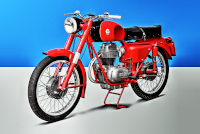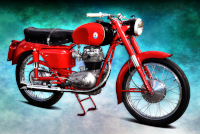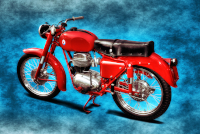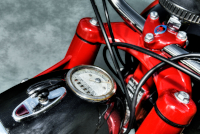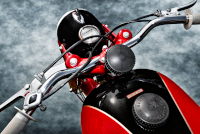Location:
Amelia Island Concours d'Elegance, 2025
Owner: James & Sharon Dillard | Greenwich, Connecticut
Prologue:
As I wandered the Amelia Island show field, hardly moving much beyond the classic era greats near the entrance after two hours, I heard Bill Rothermel mention that the motorcycle class for 2025 featured the motorcycles of automobile manufacturers. (Or at least those of the same name.) With my mind trending toward Maserati, I figured on seeing one of the marque's rare bikes, and quickly walked over to find this Tipo L 160.
Obviously there is variance among automobile names in the motorcycle word. Fratelli Ferrari, for example, bear no relation to Enzo Ferrari, whereas BMW are well known in both the two and four-wheel worlds. Maserati are somewhere in the middle.
Built on Italmoto, the marque is not wholly Maserati's own creation. But then the branch becomes another product of the marque's age-old spark plug and battery factory, very much the heart of Alfieri's industry, and the automotive concern is itself built on Diatto to begin with.
Some twelve years pass between the formation of the Bolognese Società Anonima Officine Alfieri Maserati in 1914, and the Tipo 26 Grand Prix car, Alfieri's first in-house automotive design. Under Adolfo Orsi (or rather, his sister Ida), only a few years pass between the Italmoto acquisition in 1953 and the first in-house Tipo L 125.
In any case, devotional fans will always try to strengthen these connections, pointing out historical coincidence. In the end, the Maserati motorcycle is a rarity, though not dissimilar to a period MV Agusta. Particularly in the case of this 160 cc example, the resemblance to MV Agusta is strong, and one could be forgiven for overlooking the trident badge. In this sense, the object is more an Italian bike than it is a Maserati.
- - - - - - - - - -
► Image Source: Nikon D750 (24.3 MP)
References:
- Crump, Richard; de la Rive Box, Rob. "Maserati Sports, Racing and GT Cars from 1926" Third Edition, G.T. Foulis & Company for Haynes Publishing Group PLC, Somerset, England. 1992, page 331
Compared to its lesser kin, the 160 uses a vertical single-cylinder unit with a blocky bottom end that appears to be a finned sump. The unit looks well put together, though I have no personal experience with anything of the sort and couldn't discern much compared to those more popular period Italian bikes. At the very least, Maserati build motorcycles on proven templates, beginning with Italmoto and the same DKW patent that serves Harley-Davidson's single-cylinder line.
So, appearances aside, the internals are not particularly exotic. The factory that produces the Maserati motorcycle is highly capable of volume production, having served battery and spark plug production since the very beginning of Alfieri's industrial venture. And Orsi's family industry produces the heavy machinery used in Maserati factories. So one can assume that in 1956 Maserati control enough of the supply chain to ensure a reasonable quality standard.
Otherwise, the Tipo L 160 is, at a glance, highly similar to the MV Agusta 175. The design uses a number of common elements, and the livery fits spot-on within the Italian motorcycle avant garde.
Motor: 158 cc single-cylinder, four-stroke | 60 mm x 56 mm
Power: 7.5 bhp @ 7,500 rpm
Drivetrain: 4-speed gearbox
Kerb Weight: Crump and de la Rive Box do not provide a dry weight measure.
Top Speed: 100 km/h (62.1 mph)
Etymology:
'Tipo L' denotes the flathead configuration (an L-head, or side-valve design). The '160' designation is the motor's capacity, and 'T4' an indicator that this is a four-stroke motor as opposed to the smaller two-stroke units the marque also produce.
'Turismo Lusso' signifies a touring bike as opposed to a bare version set for competition. The nomenclature is common to MV Agusta.
Figures:
By most accounts, the Maserati subsidiary produces very few motorcycles, so a handful of each model remain.
Red and Black: Similarities between Maserati and MV Agusta
The 1956 Maserati Tipo L 160 looks very much like the MV Agusta 175 of the same year. Both use A-frame down tubes to cradle the motor, fluted exhaust tip, skirted fenders, and a rather similar tank design. Of course the livery is rather identical—red and black with gold trim. Even the MV Agusta logo incorporates an azzurro hue similar to that of the Maserati trident, (though this much is coincidental). That said, the overall impression is to be an Italian sport bike, which requires looking like an Italian sport bike. So the marque's comfort with prevailing trends suggests a desire for legitimacy.
The Maserati rear frame geometry is a bit different, however, following the 125 template, and this larger-capacity bike includes a nice battery box that fully envelopes the triangular members. The front fender pattern is also lighter than MV Agusta's, with slender brims top and bottom.
Last Updated: Jul 8, 2025

